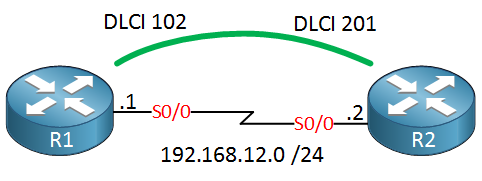EIGRP Static Neighbor
EIGRP by default uses multicast for neighbor discovery but it also allows you to configure EIGRP neighbors statically. Once you do this, EIGRP will only use unicast and disables EIGRP multicast on the selected interface.
This could be useful in certain scenarios where multicast is not supported or when you want to reduce the overhead of multicast traffic. Here’s an example:

Above we have a frame-relay hub and spoke network. The hub and spoke1 routers are the only two routers that are running EIGRP. When the hub router sends an EIGRP multicast packet, it will be replicated on all PVCs. All 4 spoke routers will receive this multicast traffic even though only spoke1 is interested in it.
In a scenario like this, it would make sense to configure the EIGRP neighbor statically so that multicast won’t be used.
Let’s see how we can configure EIGRP static neighbors…
Configuration
For this demonstration I’ll use the following two routers:

R1 and R2 are connected through frame-relay. Here’s the configuration of the interfaces:
R1#show run | begin Serial0/0
interface Serial0/0
ip address 192.168.12.1 255.255.255.0
encapsulation frame-relay
clock rate 2000000
frame-relay map ip 192.168.12.2 102
no frame-relay inverse-arpR2#show run | begin Serial0/0
interface Serial0/0
ip address 192.168.12.2 255.255.255.0
encapsulation frame-relay
clock rate 2000000
frame-relay map ip 192.168.12.1 201
no frame-relay inverse-arpAbove you can see that frame-relay Inverse ARP has been disabled, two static frame-relay maps are used for our mappings. This means that we are unable to send any broadcast or multicast traffic through this PVC. You can also verify this with the following command:
R1#show frame-relay map
Serial0/0 (up): ip 192.168.12.2 dlci 102(0x66,0x1860), static,
CISCO, status defined, activeR2#show frame-relay map
Serial0/0 (up): ip 192.168.12.1 dlci 201(0xC9,0x3090), static,
CISCO, status defined, activeAs you can see the frame-relay mappings are there but the broadcast keyword is missing. Let’s configure EIGRP to use static neighbors:
R1(config)#router eigrp 12
R1(config-router)#network 192.168.12.0
R1(config-router)#neighbor 192.168.12.2 Serial 0/0 R2(config)#router eigrp 12
R2(config-router)#network 192.168.12.0
R2(config-router)#neighbor 192.168.12.1 Serial 0/0You only have to use the neighbor command to specify the remote neighbor and the interface to reach it. After a few seconds the neighbor adjacency will appear:
R1#
%DUAL-5-NBRCHANGE: IP-EIGRP(0) 12: Neighbor 192.168.12.2 (Serial0/0) is up: new adjacencyR2#
%DUAL-5-NBRCHANGE: IP-EIGRP(0) 12: Neighbor 192.168.12.1 (Serial0/0) is up: new adjacencyYou you can also verify your static neighbors with the show ip eigrp neighbors command:
R1#show ip eigrp neighbors detail
IP-EIGRP neighbors for process 12
H Address Interface Hold Uptime SRTT RTO Q Seq
(sec) (ms) Cnt Num
0 192.168.12.2 Se0/0 154 00:01:16 34 204 0 3
Static neighbor
Version 12.4/1.2, Retrans: 0, Retries: 0Make sure you add the detail parameter or it will only show the EIGRP neighbors, not if they are static neighbors or not.
Table of Content
Unit 2: EIGRP Neighbor Adjacency
Unit 4: EIGRP Advanced Features